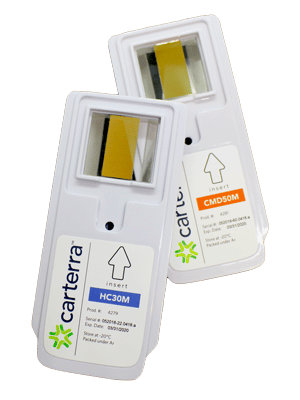
Available Biosensor Chip Chemistries
Carterra LSA Sensor Chips
Selection of the appropriate sensor chip surface is essential for robust data quality when designing a high-throughput SPR assay. Carterra offers a broad range of chip surfaces to support the diverse applications available on the LSA and LSAXT. Described here are the standard chip offerings for the LSA and LSAXT. Custom surfaces may be available upon request. Always consult with a Carterra Applications Scientist when selecting sensor chips.
| Linear polycarboxylate | ||
| Name | Description | Application |
|---|---|---|
| HC30M #4279 |
Polycarboxylate hydrogel, medium charge density, 30nm coating thickness | Moderate ligand capacity for general use |
| HC200M #4287 |
Polycarboxylate hydrogel, medium charge density, 200nm coating thickness | Higher ligand capacity for general use |
|
|
||
| Carboxymethylated dextran | ||
| Name | Description | Application |
| CMDP #4282 |
2D planar carboxymethyldextran surface, <5nm coating thickness | Lower ligand capacity for high resolution analysis |
| CMD50M #4281 |
Carboxymethyldextran hydrogel, medium charge density, 50nm coating thickness | Moderate ligand capacity for general use |
| CMD200M #4280 |
Carboxymethyldextran hydrogel, medium charge density, 200nm coating thickness | Higher ligand capacity for increased levels of immobilization |
| CMD500M #4296 |
Carboxymethyldextran hydrogel, medium charge density, 500nm coating thickness | Higher ligand capacity for maximum levels of immobilization |
|
|
||
| NiNTA | ||
| Name | Description | Application |
| NiCMDP #4298 |
 Planar NTA derivatized carboxymethyldextran, < 5nm coating thicknesss Planar NTA derivatized carboxymethyldextran, < 5nm coating thicknesss |
Very low capacity capture of His-tagged molecule |
| NiHC200M #4299 |
Poly – NTA derivatized linear polycarboxylate hydrogel, medium charge density, 200nm coating thickness | High capacity for His-tagged ligand captures |
|
|
||
| Streptavidin | ||
| Name | Description | Application |
| SAP #4295 |
Streptavidin immobilized on 2D planar carboxymethyl dextran surface, <5nm coating thickness | Very low capacity for arraying of biotinylated ligands |
| SAHC30M #4294 |
Streptavidin, immobilized in polycarboxylate hydrogel, medium charge density, 30nm coating thickness |
Lower capacity for biotinylated ligand kinetic lawns |
| SAD200M #4283 |
Streptavidin, immobilized in a carboxymethyldextran hydrogel, medium charge density, 200nm coating thickness |
High capacity for biotinylated ligand captures |
| RSA200M Kit #4365 |
 Oligonucleotide derivatized carboxymethyldextran for reversible immobilization of biotinylated ligands, 200nm coating thickness. RSA reagent included. Oligonucleotide derivatized carboxymethyldextran for reversible immobilization of biotinylated ligands, 200nm coating thickness. RSA reagent included. |
Medium capacity reversible capture of biotinylated molecules |
|
|
||
| Protein A | ||
| Name | Description | Application |
| PAHC200M #4291 |
Protein A derivatized linear polycarboxylate hydrogel, medium charge density, 200nm coating thickness |
High capacity for quantitation of human IgG |
|
|
||
| Protein A/G | ||
| Name | Description | Application |
| PAGP #4277 |
 Planar protein A/G derivatized carboxymethyldextran, < 5nm coating thickness Planar protein A/G derivatized carboxymethyldextran, < 5nm coating thickness |
Very low capacity capture of Fc-containing molecules |
| PAGHC30M #4292 |
Protein A/G derivatized linear polycarboxylate hydrogel, medium charge density, 30nm coating thickness |
Moderate capacity for kinetics of multi-species IgG |
| PAGHC200M #4293 |
Protein A/G derivatized linear polycarboxylate hydrogel, medium charge density, 200nm coating thickness | High capacity for quantitation of multi-species IgG |
Notes
While CMD is a well described chemistry for use in biosensors, the linear polycarboxylate chemistry of HC chips provides an alternate surface chemistry to that of CMD in instances of non-specific binding or when differential diffusion characteristics are warranted.
CMD and HC sensor chips can be used to build custom capture surfaces such as anti-mouse or Protein A/G via amine coupling of capture molecules.
When stored at -20 °C CMD and HC surfaces are good for 4 years after purchase, while protein derivatized coatings such as SAD should be used within 2 years.
